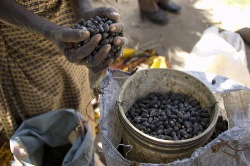 After discovering the disastrous consequences of turning its own food crops into fuel, China has turned to cassava — mostly from southeast Asia — as a source for biofuels. Europe, meanwhile, is buying up tracts of "marginal land" in Africa in order to grow jatropha for biofuels. In the U.S., of course, it's corn for ethanol.
After discovering the disastrous consequences of turning its own food crops into fuel, China has turned to cassava — mostly from southeast Asia — as a source for biofuels. Europe, meanwhile, is buying up tracts of "marginal land" in Africa in order to grow jatropha for biofuels. In the U.S., of course, it's corn for ethanol.
The developed world's modest proposal is this: Take calories that might otherwise have gone to feed humans or their livestock, and turn them into energy to fuel our motor vehicles instead. In theory, say advocates of biofuel, next-generation fuels will be made from crops that people and animals can't eat. But that doesn’t mean farmers won’t grow them instead of food, if the incentive is strong enough, which it probably is. So: Fewer hungry cars, more hungry people.
The relationship between demand for biofuel and the price of food is complicated, but experts agree that the demand for fuel is one reason that the United Nations Food and Agriculture Organization index of food prices hit a twenty-year high this year.
Another reason for record food prices is extreme weather. Gee, wonder what could be causing that?




